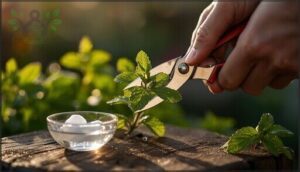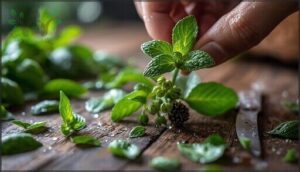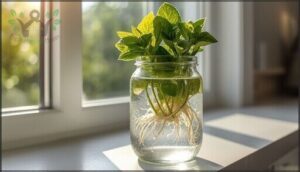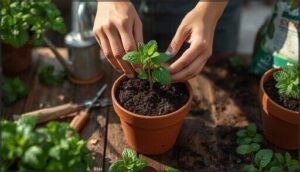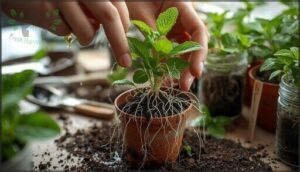This site is supported by our readers. We may earn a commission, at no cost to you, if you purchase through links.

This vigorous growth happens because mint stems naturally produce adventitious roots at nodes, the small bumps where leaves emerge. While root hormones accelerate the process for reluctant plants like roses or azaleas, mint’s biology already favors rapid propagation.
Understanding when to take cuttings, how to prepare them properly, and which environment encourages fastest root development transforms a single healthy stem into an entire container garden within three weeks.
Table Of Contents
Key Takeaways
- Mint cuttings achieve 90-100% rooting success in plain water without synthetic hormones because their stems naturally produce adventitious roots at nodes, making commercial rooting products unnecessary.
- Spring propagation delivers the highest success rates, with optimal conditions requiring 4-7 inch softwood stems cut at 45-degree angles just below a node, lower leaves removed, and placement in bright indirect light at 55-70°F.
- Natural alternatives like aloe vera, honey, and cinnamon match commercial hormone effectiveness with 95% rooting success rates while providing antibacterial and antifungal protection during the 7-14 day root development period.
- Transplant rooted cuttings when roots reach 2-3 inches, but immediately implement containment barriers or use containers since mint’s aggressive rhizome growth can expand coverage by 200-400% annually without control measures.
Best Time to Propagate Mint
Timing makes all the difference when you’re propagating mint. You’ll get the best results when you work with the plant’s natural growth cycles and choose strong, healthy stems to start with.
Let’s look at when to take your cuttings and how to pick parent plants that’ll give you thriving new mint.
Optimal Seasons for Propagation
Spring propagation delivers near-perfect results, with early-season mint cuttings rooting at up to 100% success rates. You’ll see the fastest growth during this time, as stems establish roots before summer heat arrives.
Summer challenges include increased watering needs and heat stress, while autumn rooting succeeds if you plant six to eight weeks before frost. Climate impact matters—northern gardens need early spring starts, while southern regions support year-round propagation.
To begin, use a mint plant with fresh top growth for the best results.
Choosing Healthy Parent Plants
Once you’ve picked your timing, selecting healthy plants becomes your foundation for success. Visual inspection reveals what you need: vibrant green stems without yellowing, firm leaves free from holes or sticky residues, and no signs of powdery mildew or rust.
Pest management matters too. Before taking cuttings, check for:
- Aphids clustering on new growth
- Spider mite webbing underneath leaves
- Whiteflies disturbing easily when touched
- Discolored spots indicating disease
Nutrient status and growing conditions affect stem characteristics. Healthy mint plants grown in well-aerated soil with consistent moisture produce the sturdy, non-flowered stems you’ll want for propagation. It’s important to select stems with several healthy leaf nodes for best results.
Selecting and Preparing Mint Cuttings
The secret to propagating mint without root hormone starts with choosing the right cuttings from your parent plant. You’ll need to know what a healthy stem looks like, how to cut it properly, and which leaves to remove before rooting.
Let’s walk through each step so your cuttings have the best chance of developing strong roots.
Identifying Suitable Stems

When you propagate mint, choosing the right stem cuttings makes all the difference. Look for softwood stems 4–7 inches long from healthy plants—stems less than a year old root 88% of the time, compared to just 65% for woody growth. Avoid flowering stems; they’ve already invested energy elsewhere.
Your ideal cutting has turgid leaves, no yellowing or pest damage, and a sturdy structure. Cut just below a node—that’s where 95% of roots emerge. Disease prevention starts here: clean, undamaged stems reduce failure by 40%.
| Feature | What to Look For |
|---|---|
| Stem Age | Young, flexible growth (softwood) |
| Stem Health | Vibrant green, firm, disease-free |
| Node Position | At least 1–2 visible leaf nodes |
| Stem Thickness | ≥3 mm diameter for best results |
Cutting Technique and Tools
Once you’ve identified the right stems, you’ll need sharp, clean tools—a knife, scissors, or pruning shears. Disinfect them with rubbing alcohol before each cut to prevent disease transmission, which can slash your success rate by 30%. Make a 45-degree angled cut just below a node using smooth, decisive motions. Blade sharpness matters: clean cuts boost root formation by 20% compared to crushed tissue.
- Sanitize religiously—cross-contamination steals your future harvest
- Angle your cuts—more surface area means faster, stronger roots
- Keep blades razor-sharp—ragged edges invite rot and failure
- Cut with confidence—precision now means thriving plants later
Removing Leaves and Buds
After cutting, strip the lower third of your mint cutting to redirect energy toward root formation rather than foliage maintenance. Remove 2-3 leaves nearest the base, preserving top leaves for photosynthesis. Pinch off all flower buds—Bud Inhibition forces Nutrient Redirection downward.
Leaf nodes below water invite rot, slashing Rooting Success by 40%. This Transpiration Reduction and Fungal Prevention step transforms preparing mint cuttings from guesswork into predictable science.
Rooting Mint Cuttings in Water
Water propagation is the simplest method for rooting mint cuttings, requiring nothing more than a clean container and fresh water. You’ll see roots emerge in as little as a week when you provide the right conditions.
Here’s how to set up your cuttings for success and watch them develop strong roots before transplanting.
Step-by-Step Water Propagation
Water propagation is surprisingly straightforward when you follow a few key steps. Place your mint cuttings in a container with about 1 inch of clean water, ensuring leaves stay above the water level to prevent rot.
Change the water every 2-3 days to discourage algae growth and maintain oxygen.
You’ll notice roots appearing within 7-14 days, reaching 2-3 inches in just 2-3 weeks—perfect for transplanting.
Ideal Light and Temperature Conditions
Since mint cuttings thrive in bright, indirect sunlight with light intensity between 400–800 μmol m⁻² s⁻¹, place your container near a sunny window that provides 12–16 hours of photoperiod effects daily.
Maintain a temperature range of 55–70°F (13–21°C) for best rooting, whether you’re growing mint indoors or outdoors.
The ideal environment for mint includes humidity control above 70% and interaction effects between consistent light and moderate warmth, which boost success rates by up to 35%.
Monitoring Root Development
You can expect root emergence timing between 7 and 14 days when water propagation goes well. Quantifying root growth means watching for white, firm new roots reaching 2 to 5 cm—that’s your cue to transplant.
Check root health indicators daily: clear water, no browning, and visible branching signal success. Assessment frequency matters, so peek every day or two without disturbing your rooting cuttings.
Rooting Mint Cuttings in Soil
If you’d rather skip the water method, rooting your mint cuttings directly in soil works just as well. This approach gets your plants established faster since they won’t need that adjustment period from water to soil.
Let’s walk through the soil mix you’ll need, how to keep moisture levels just right, and what your cuttings need to thrive.
Choosing The Right Soil Mix
You’ll set your mint cuttings up for success by mixing the right growing medium. A blend of potting soil, compost, and perlite—roughly 2:1:1—creates ideal Soil Texture with excellent Drainage Needs. Aim for Soil pH between 5.5 and 6.5, and include 20–30% Organic Matter to support healthy roots.
Commercial Mixes designed for propagation work beautifully, delivering consistent results every time.
Planting and Moisture Control
Once you’ve prepped your rooted mint cuttings, planting depth matters—just enough to cover roots, about 0.25 to 0.5 inches. Press moist soil gently around each stem.
Your watering techniques should keep soil moisture consistent: check one inch deep, irrigate when dry. Use containers with a drainage hole to prevent overwatering effects.
Timing factors like spring planting and humidity control help garden soil stay perfectly balanced.
Caring for Soil-Rooted Cuttings
Your soil-rooted cuttings need humidity management above 60%—cover them with clear plastic to boost survival by 30%. Watering practices keep moist soil at 60–80% moisture; check that top inch daily. Nutrient needs call for diluted fertilizer after roots establish.
Position cuttings in indirect sunlight, avoiding direct rays. Disease prevention means good air circulation and a drainage hole in every container.
Natural Alternatives to Root Hormone
You don’t need commercial rooting hormone to successfully propagate mint. Several household items work just as well, thanks to their natural antibacterial and antifungal properties.
Let’s look at three simple alternatives you probably already have in your kitchen.
Using Aloe Vera, Honey, and Cinnamon
Beyond commercial powders, you can turn to natural rooting hormone alternatives like aloe vera, honey, and cinnamon for mint propagation methods. Aloe vera contains salicylic acid that signals root formation, honey offers antimicrobial protection through glucose oxidase, and cinnamon suppresses fungal pathogens.
While DIY rooting enthusiasts report success, scientific studies show natural efficacy varies by species, with honey benefits particularly notable for soft-stemmed herbs like mint.
Benefits and Application Methods
Each of these natural rooting hormone alternatives offers distinct propagation benefits through antibacterial and antifungal agents. For water application, dip your cutting’s base in aloe vera gel or diluted honey before submerging.
With soil application, dust cinnamon on the cut end or apply honey directly to promote plant cell division.
Using natural substances aids health influence while providing risk mitigation against pathogens during natural rooting.
Effectiveness Compared to Commercial Hormones
You’ll be glad to know natural alternatives stack up well when you propagate mint cuttings. Rooting success rates hover around 95% with aloe vera or willow water—matching commercial hormones.
Natural alternatives like aloe vera and willow water achieve 95% rooting success rates, matching commercial hormones for mint propagation
The rooting time comparison shows naturals lag just 5–7 days behind synthetics, but mint’s already rapid. Natural agent efficacy rivals store-bought options while cutting hormone cost analysis and environmental impact, making them practical for plant propagation.
Transplanting and Caring for New Mint Plants
Once your mint cuttings have developed roots that are at least one to two inches long, they’re ready to move into their permanent home.
The shift from water or starter soil to a full growing environment requires attention to timing, location, and ongoing management.
Let’s walk through when and how to transplant your rooted cuttings, whether you’re planting indoors or outdoors, and how to keep your mint thriving without letting it take over your garden.
When to Transplant Rooted Cuttings
Your rooted cuttings are ready when roots reach 2–3 inches and white, healthy secondary roots appear—usually within 7–15 days.
Transplanting mint cuttings works best in spring after frost, when soil temperatures exceed 55°F. Visual cues like upright stems and new leaf growth signal readiness.
Transplant during evening hours to minimize transplant shock, water thoroughly, and provide shade for 48–72 hours during this critical adjustment period.
Outdoor Vs. Indoor Planting
Growing mint indoors gives you year-round harvests with predictable light requirements—aim for 6 hours of bright, indirect sunlight daily. Indoor mint cuttings avoid aphids and spider mites but need consistent watering needs monitoring.
Growing mint outdoors, however, delivers faster growth rates and higher yields, though you’ll face more pest differences and temperature tolerance challenges. Propagating mint in containers simplifies control; outdoor beds let mint thrive naturally with rainfall and direct sun.
Managing Mint Growth and Spread
Once your mint plant is established, containment methods become essential—this herb’s rhizome behavior can expand coverage by 200–400% annually without barriers. Install 12–18-inch root barriers or use containers to prevent mint from spreading into adjacent beds.
Regular pruning impacts growth speed, reducing lateral expansion by up to 40%. Biweekly harvests keep runners in check while protecting native plants from this moderately invasive species.
Frequently Asked Questions (FAQs)
Can mint cuttings root in plain tap water?
Want to know if you can skip the fancy stuff? Yes, mint cuttings root easily in plain tap water—success rates hit 90-100% when you change water regularly and provide bright, indirect light.
How long do mint cuttings survive before planting?
If you plan water propagation, your cuttings can stay fresh in water for up to two months.
For dry storage in cool, dark conditions, you’re looking at roughly two weeks maximum before viability drops.
Why do some mint cuttings turn yellow or brown?
Picture your mint cuttings wilting in their glass—yellow leaves, brown leaves signal trouble. Sunlight exposure, overwatering signs, nutrient deficiency, fungal infections, or pest damage often derail propagation methods when rooting mint cuttings.
Can you propagate mint from store-bought herbs?
Yes, you can propagate mint from store-bought herbs if the stems are fresh and healthy. Choose cuttings with vibrant leaves and firm stems, though herb freshness and source quality affect success rates in water propagation.
Do different mint varieties root at different speeds?
Most mint varieties root at nearly identical speeds under standard conditions. Peppermint, spearmint, and other mint cuttings develop roots within 7–14 days in water, with rooting speed factors like temperature and humidity mattering more than variety morphology impact.
Conclusion
Before smartphones tracked every plant’s progress, gardeners knew mint as the quintessential beginner’s ally—a species that propagates itself with minimal intervention. Your success doesn’t hinge on commercial products.
Taking healthy cuttings during active growth, providing consistent moisture, and maintaining indirect light creates ideal conditions to propagate mint without root hormone.
Within three weeks, vigorous roots transform single stems into independent plants, proving that nature’s design often surpasses laboratory formulations for straightforward propagation tasks.
- https://www.gardenary.com/blog/how-to-propagate-mint-in-3-easy-steps
- https://www.reddit.com/r/gardening/comments/18ulr6d/what_is_the_deal_with_mint_roots_in_water_vs_soil/
- https://www.azurefarmlife.com/farm-blog/growing-your-own-mint
- https://traditionalcookingschool.com/raising-food/how-to-grow-mint-from-cuttings/
- https://extension.usu.edu/yardandgarden/research/mint-in-the-garden.pdf

